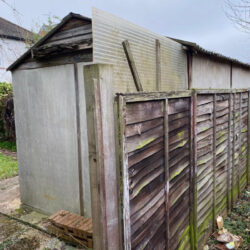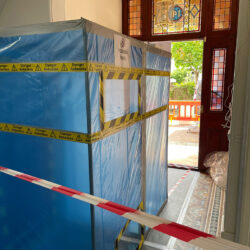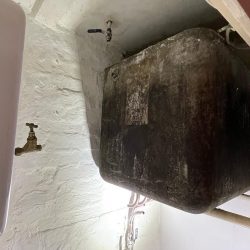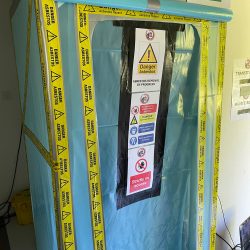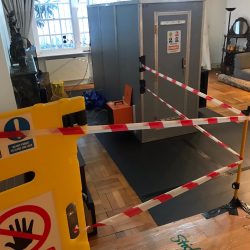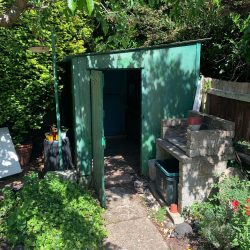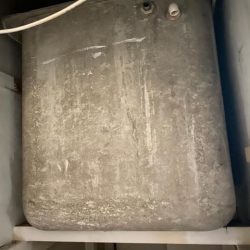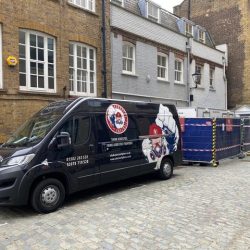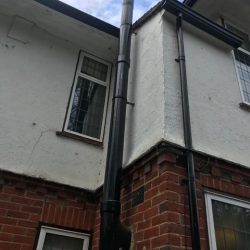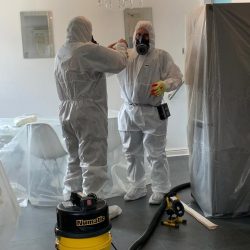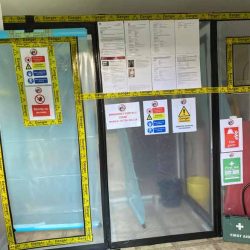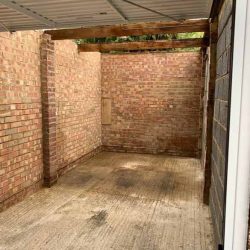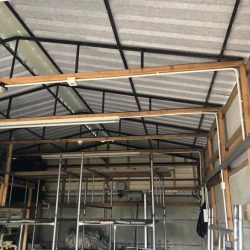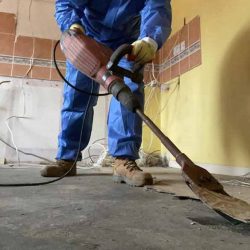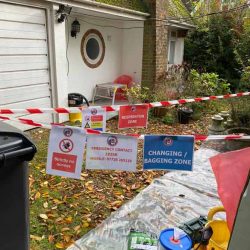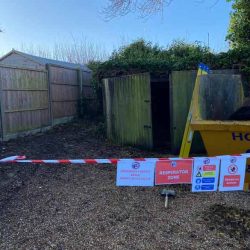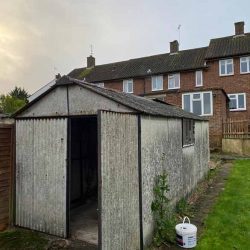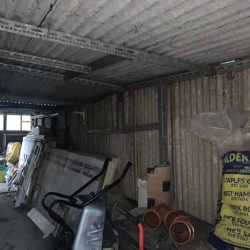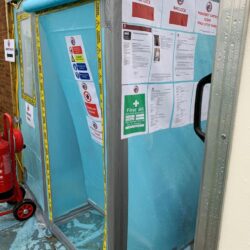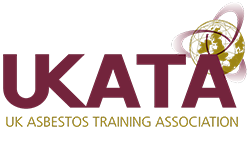Asbestos Shed Removal, Hertfordshire
One of our remarkable teams successfully aided a client in the meticulous asbestos shed removal, ensuring its safe extraction down to the very foundation level. With unparalleled expertise and adherence to stringent safety protocols, our team diligently dismantled and disposed of the hazardous materials, mitigating any potential risks associated with asbestos exposure.
The process involved a comprehensive assessment of the site, meticulous planning, and the utilisation of cutting-edge equipment designed to handle asbestos abatement. Our proficient experts dismantled the shed, employing state-of-the-art techniques to prevent the dispersion of asbestos fibres into the environment.
Prioritising safety as the utmost concern, our team sealed and contained the area throughout the removal process, utilising advanced engineering controls to prevent the spread of any particulates. Rigorous decontamination procedures were followed, leaving the site entirely free from any residual traces of asbestos contamination.
Ultimately, through the dedicated efforts of our adept team, the client's property was effectively cleansed of asbestos, eliminating any potential health hazards. This accomplishment underscores our commitment to ensuring not only the successful execution of complex projects, but also the well-being of our clients and the environment.
The process involved a comprehensive assessment of the site, meticulous planning, and the utilisation of cutting-edge equipment designed to handle asbestos abatement. Our proficient experts dismantled the shed, employing state-of-the-art techniques to prevent the dispersion of asbestos fibres into the environment.
Prioritising safety as the utmost concern, our team sealed and contained the area throughout the removal process, utilising advanced engineering controls to prevent the spread of any particulates. Rigorous decontamination procedures were followed, leaving the site entirely free from any residual traces of asbestos contamination.
Ultimately, through the dedicated efforts of our adept team, the client's property was effectively cleansed of asbestos, eliminating any potential health hazards. This accomplishment underscores our commitment to ensuring not only the successful execution of complex projects, but also the well-being of our clients and the environment.
Asbestos Insulation Board Removal, SW London
The meticulous process of Asbestos Insulation Board removal demands paramount attention and precision. Such was the case in a recent job undertaken in the under stairs cupboard of a property situated in the vibrant landscape of SW London. The significance of this operation was underscored by the stringent adherence to Fully Controlled Conditions, a comprehensive framework ensuring that every facet of the removal procedure was scrupulously managed to prevent any potential release of harmful asbestos fibres.
Prior to the commencement of this intricate task, a 14-day notification period was observed, as mandated by the Health and Safety Executive (HSE). This allowed for the orchestration of a meticulously calculated plan that encompassed every conceivable precaution. Our team of dedicated professionals, equipped with specialised gear and an unwavering commitment to safety, embarked on this mission.
Despite the inherent complexities of asbestos abatement, the team showcased their expertise by seamlessly completing the project within a single day. This feat not only underscored their efficiency but also exemplified the gravity of preparation and organisation involved in handling hazardous materials.
The successful execution of the Asbestos Insulation Board removal project under the confined space of an under stairs cupboard in SW London stands as a testament to the significance of meticulous planning, adherence to regulations, and the proficient execution of intricate procedures when dealing with hazardous materials.
Prior to the commencement of this intricate task, a 14-day notification period was observed, as mandated by the Health and Safety Executive (HSE). This allowed for the orchestration of a meticulously calculated plan that encompassed every conceivable precaution. Our team of dedicated professionals, equipped with specialised gear and an unwavering commitment to safety, embarked on this mission.
Despite the inherent complexities of asbestos abatement, the team showcased their expertise by seamlessly completing the project within a single day. This feat not only underscored their efficiency but also exemplified the gravity of preparation and organisation involved in handling hazardous materials.
The successful execution of the Asbestos Insulation Board removal project under the confined space of an under stairs cupboard in SW London stands as a testament to the significance of meticulous planning, adherence to regulations, and the proficient execution of intricate procedures when dealing with hazardous materials.
Asbestos Cement Water Tank Removal, Buckinghamshire
We were asked by a plumbing and heating specialist to complete an asbestos cement water tank removal for one of their customers.
We work with this company regularly - they care about the health and safety of their team and their clients - and they appreciate the quality of service they receive from us is consistent and we are reliable and get the job done quickly without delaying their own time frame.
We work with this company regularly - they care about the health and safety of their team and their clients - and they appreciate the quality of service they receive from us is consistent and we are reliable and get the job done quickly without delaying their own time frame.
Asbestos Insulation Board Removal & Disposal, Old Coulsdon, Croydon
We removed the Asbestos Insulation Boards fire break between the two properties loft spaces under fully controlled conditions. Due to the layout and dimensions of the property, the airlocks were located on the ground floor and connected to the enclosure on the landing by a tunnel. We designed the enclosure to be free standing as far as reasonably practical and was only connected to the property’s hatch, which meant we were able to undertake our works safely without causing any damage to the décor.
Work for the asbestos insulation board removal included:
1. Several site visits and meetings to decide on the best plan of action for all parties;
2. Undertook the risk assessment for all site hazards that would or could become issues during the removal;
3. Designed our enclosures and setups;
4. Produce the site-specific RAMs, site packs;
5. Allocated the Team, ordered the materials and plant and planned the mobilisation;
6. The team and the manager met on the first morning of the project and went through the whole programme during a site walk around;
7. Then the site was set up and the works were undertaken;
8. After the air testing, we installed a new fire barrier in the loft space between the two loft spaces.
Work for the asbestos insulation board removal included:
1. Several site visits and meetings to decide on the best plan of action for all parties;
2. Undertook the risk assessment for all site hazards that would or could become issues during the removal;
3. Designed our enclosures and setups;
4. Produce the site-specific RAMs, site packs;
5. Allocated the Team, ordered the materials and plant and planned the mobilisation;
6. The team and the manager met on the first morning of the project and went through the whole programme during a site walk around;
7. Then the site was set up and the works were undertaken;
8. After the air testing, we installed a new fire barrier in the loft space between the two loft spaces.
Pipe Lagging Removal
We recently carried out asbestos pipe lagging removal at a private residence in Central London. As you can see from the images, we ensure that nothing was missed when it came to setting up safely and carrying out the works to ensure both our team and the family were safe throughout the process.
Asbestos Cement Shed Removal Watford
This recent asbestos cement shed removal job required the Asbestos Fighters team to remove and dispose of a small asbestos cement shed.
The solid shed was built over 30 years ago and was still standing. However our client didn’t enjoy a look of it in his garden and wanted it removed so he could replace it with something more modern.
Our team thrive on helping local communities deal with any asbestos related matters - no job is too small!
The solid shed was built over 30 years ago and was still standing. However our client didn’t enjoy a look of it in his garden and wanted it removed so he could replace it with something more modern.
Our team thrive on helping local communities deal with any asbestos related matters - no job is too small!
AIB Panel Removal
AIB Panel Removal and disposal under Fully Controlled Condition (FCC)
We helped our client to remove and dispose asbestos safely and efficiently. This type of work was Notified to HSE – 14 Days Notification prior to removal work.
All process started from single site visit where we have assessed garage ceiling AIB panel removal. Our client has had a leak through old roof, and re-roofing work could not be carried out without asbestos removal by fully licensed contractor. We took all measurements and we provided quotation within 24 hours.
Upon acceptance, we start preparation of Plan of Work included full list of equipment and materials required to complete this project safely.
Once all paperwork was fully verified by another asbestos manager, we submitted ASB5 Notification to HSE and we placed the order with our suppliers.
Job took five days from start to completion.
We helped our client to remove and dispose asbestos safely and efficiently. This type of work was Notified to HSE – 14 Days Notification prior to removal work.
All process started from single site visit where we have assessed garage ceiling AIB panel removal. Our client has had a leak through old roof, and re-roofing work could not be carried out without asbestos removal by fully licensed contractor. We took all measurements and we provided quotation within 24 hours.
Upon acceptance, we start preparation of Plan of Work included full list of equipment and materials required to complete this project safely.
Once all paperwork was fully verified by another asbestos manager, we submitted ASB5 Notification to HSE and we placed the order with our suppliers.
Job took five days from start to completion.
Flue Pipe Removal – Loudwater
Another callout by coming back client.
We love coming back clients, especially these ones who care about health and safety of their workmen and clients.
Easy job, asbestos containing flue pipe was safely removed and disposed in accordance with HSE Guidance.
This work enabled Central Heating Engineers to carry out new boiler installation.
Small work, but how important!
We love coming back clients, especially these ones who care about health and safety of their workmen and clients.
Easy job, asbestos containing flue pipe was safely removed and disposed in accordance with HSE Guidance.
This work enabled Central Heating Engineers to carry out new boiler installation.
Small work, but how important!
Emergency Asbestos Clean Up – Kings Langley
The emergency asbestos clean up process began with a single site visit where we had been informed by our client about the situation and why they required our service. We talked about our procedures and how we can help them. Our proposed quotation was accepted.
Upon acceptance, we started preparation of the Plan of Work which included a full list of equipment and materials required to complete this project safely. We booked an independent analyst to carry out an air test.
We began the work by forming a respirator zone around the kitchen area using 1000 polythene sheets with the flaps and warning signs in place. A changing and bagging zone was created outside the kitchen with the H type vacuum and bucket with water and sponge in place. Analysts carried out a reassurance air test and personal monitoring on our operative. Samples were taken to further analyses.
The emergency asbestos clean up works were started on Wednesday 7th October 2020 at 8am and was completed by 12noon the same day.
Upon acceptance, we started preparation of the Plan of Work which included a full list of equipment and materials required to complete this project safely. We booked an independent analyst to carry out an air test.
We began the work by forming a respirator zone around the kitchen area using 1000 polythene sheets with the flaps and warning signs in place. A changing and bagging zone was created outside the kitchen with the H type vacuum and bucket with water and sponge in place. Analysts carried out a reassurance air test and personal monitoring on our operative. Samples were taken to further analyses.
The emergency asbestos clean up works were started on Wednesday 7th October 2020 at 8am and was completed by 12noon the same day.
Asbestos Re-encapsulating Soffits – Bedfordshire
Asbestos Fighters were contacted by a school in Bedfordshire as they were concerned about the soffits on their building.
After a thorough inspection of the soffits, we advised the school that they could in fact be encapsulated - covered up so that they were protected with Asbestos Insulation Board (AIB) - instead of being removed.
This work was completed without any disruption to the routine or safety of the pupils at the school.
Following the re-encapsulating soffits work, we will now carry out an annual inspection to ensure they continue to be protected against the elements, keeping the pupils and staff safe.
After a thorough inspection of the soffits, we advised the school that they could in fact be encapsulated - covered up so that they were protected with Asbestos Insulation Board (AIB) - instead of being removed.
This work was completed without any disruption to the routine or safety of the pupils at the school.
Following the re-encapsulating soffits work, we will now carry out an annual inspection to ensure they continue to be protected against the elements, keeping the pupils and staff safe.
Asbestos Pipe Insulation Debris Removal – Havering-atte-Bower, Essex
This pipe insulation debris was removed from this client's piano room in their home under fully controlled conditions.
When carrying out pipe insulation debris removal work, we are required to give 14 days notification prior to the asbestos works beginning. Our team prepared a Plan of Work and had it verified before we submitted the ASB5 Notification to the Health & Safety Executive (HSE).
The asbestos removal work was carried out under fully controlled conditions, under a negative pressure unit. A Decontamination Unit, including Welfare and WC, was located on the front of the house, and we had all transit procedures in place.
All the work was completed in two days.
When carrying out pipe insulation debris removal work, we are required to give 14 days notification prior to the asbestos works beginning. Our team prepared a Plan of Work and had it verified before we submitted the ASB5 Notification to the Health & Safety Executive (HSE).
The asbestos removal work was carried out under fully controlled conditions, under a negative pressure unit. A Decontamination Unit, including Welfare and WC, was located on the front of the house, and we had all transit procedures in place.
All the work was completed in two days.
Asbestos Single Garage Re-Roof – Borehamwood, Hertfordshire
We were contacted by this client with regards to removing possible asbestos corrugated roof sheets on the property in Borehamwood. After answering their questions about how we work and the safety practises we adhere to, we were asked to take on the job.
Work began promptly at 8am on the day and the asbestos was safely removed and sent to be disposed of securely by 10am. At this point, the roofing team began replacing the garage roof and the entire job was completed by lunchtime. This kind of time frame ensures other building works do not need to be hindered when asbestos removal is carried out safely and to the standards expected of a company like Asbesstos Fighters.
Work began promptly at 8am on the day and the asbestos was safely removed and sent to be disposed of securely by 10am. At this point, the roofing team began replacing the garage roof and the entire job was completed by lunchtime. This kind of time frame ensures other building works do not need to be hindered when asbestos removal is carried out safely and to the standards expected of a company like Asbesstos Fighters.
Asbestos Garage Roof Removal – Dunstable, Bedfordshire
This asbestos removal job required our team to safely remove the roof of a double garage in Borehamwood.
The asbestos present was chrysotile asbestos, or white asbestos as it is more commonly known.
Our two operatives began the job at 8am and was handed back to the builders at 12noon.
The asbestos present was chrysotile asbestos, or white asbestos as it is more commonly known.
Our two operatives began the job at 8am and was handed back to the builders at 12noon.
Asbestos Floor Tile & Bitumen Removal – Wheathamstead, Hertfordshire
Job started in the morning at 8 o’clock, asbestos was safely removed by 10am, and roofers started new roof installation. Whole job was fully completed by lunch time.
Asbestos Soffits Removal – Bedfordshire
Asbestos Fighters were asked to carry out an asbestos survey on soffits on a residential property in Bedfordshire by builders who were undertaking extensive works on the property.
The survey took approximately half a day to complete and the results around five days to arrive. Once we had them and had confirmation that asbestos was, in fact, present in the soffits, the builders asked us to undertake the works to ensure that their deadlines were not disrupted.
The soffits removal and disposal took our team half a day to do and the builders were then free to continue their renovation works safely.
The survey took approximately half a day to complete and the results around five days to arrive. Once we had them and had confirmation that asbestos was, in fact, present in the soffits, the builders asked us to undertake the works to ensure that their deadlines were not disrupted.
The soffits removal and disposal took our team half a day to do and the builders were then free to continue their renovation works safely.
Asbestos Roof Sheet Removal – Luton, Bedfordshire
This garage asbestos roof sheet removal at a residential property in Luton, Bedfordshire was completed professionally in just a couple of hours.
The client's plan was to convert their garage into a spare bedroom so it was vital that the works were carried out by a reputable company who would complete the works when promised so the conversion works were not delayed.
With this particular garage roof asbestos removal job, there was an issue as you couldn't actually see the roof as it was hidden behind overgrown bushes. However, this did not hinder our team who overcame this obstacle quickly and efficiently!
The client's plan was to convert their garage into a spare bedroom so it was vital that the works were carried out by a reputable company who would complete the works when promised so the conversion works were not delayed.
With this particular garage roof asbestos removal job, there was an issue as you couldn't actually see the roof as it was hidden behind overgrown bushes. However, this did not hinder our team who overcame this obstacle quickly and efficiently!
Asbestos Shed removal – St. Albans, Hertfordshire
We carried out the disposal and removal of this garden shed in St. Albans after it was found to contain chrysotile asbestos.
The job was pre-booked through the client's architect who was planning the home-owners major renovation works and needed a company he could trust so ensure the job was completed properly and didn't delay the rest of the works.
The job included the removal and disposal of the corrugated shed as well as clearing the site where it was located.
The job was pre-booked through the client's architect who was planning the home-owners major renovation works and needed a company he could trust so ensure the job was completed properly and didn't delay the rest of the works.
The job included the removal and disposal of the corrugated shed as well as clearing the site where it was located.
Asbestos Garage Roof Removal – South West London
The removal and disposal of the roof slates and corrugated sheets from the garage wall which both contained asbestos were part of enabling works we completed in South West London. After our initial asbestos survey, the actual garage roof was found to not contain any asbestos so the works could be completed without having to remove it. We were pleased to be able to give our clients this news and, as always, provide honest advice and on-site surveys. This shows the importance of carrying out an asbestos survey as they can show that some works are unnecessary.
These chrysotile asbestos removal works were quite last minute but we were able to accommodate them on a Saturday and were completed in one day.
These chrysotile asbestos removal works were quite last minute but we were able to accommodate them on a Saturday and were completed in one day.
Asbestos Insulation Board Removal – Haynes, Bedfordshire
We helped our client to remove and dispose asbestos safely and efficiently. This type of work was Notified to HSE – 14 Days Notification prior to removal work.
All process started from single site visit where we have assessed garage ceiling. Our client has had a leak through old roof, and re-roofing work could not be carried out without asbestos removal by fully licensed contractor. We took all measurements and we provided quotation on spot.
Upon acceptance, we start preparation of Plan of Work included full list of equipment and materials required to complete this project safely.
Once all paperwork was fully verified by another asbestos manager, we submitted ASB5 Notification to HSE and we placed the order with our suppliers.
One day before work started, we came to site with a supervisor and one of our operatives to walk through the project and to take deliveries from our suppliers.
Job started on Saturday and was fully completed by Sunday 4PM.
All process started from single site visit where we have assessed garage ceiling. Our client has had a leak through old roof, and re-roofing work could not be carried out without asbestos removal by fully licensed contractor. We took all measurements and we provided quotation on spot.
Upon acceptance, we start preparation of Plan of Work included full list of equipment and materials required to complete this project safely.
Once all paperwork was fully verified by another asbestos manager, we submitted ASB5 Notification to HSE and we placed the order with our suppliers.
One day before work started, we came to site with a supervisor and one of our operatives to walk through the project and to take deliveries from our suppliers.
Job started on Saturday and was fully completed by Sunday 4PM.
